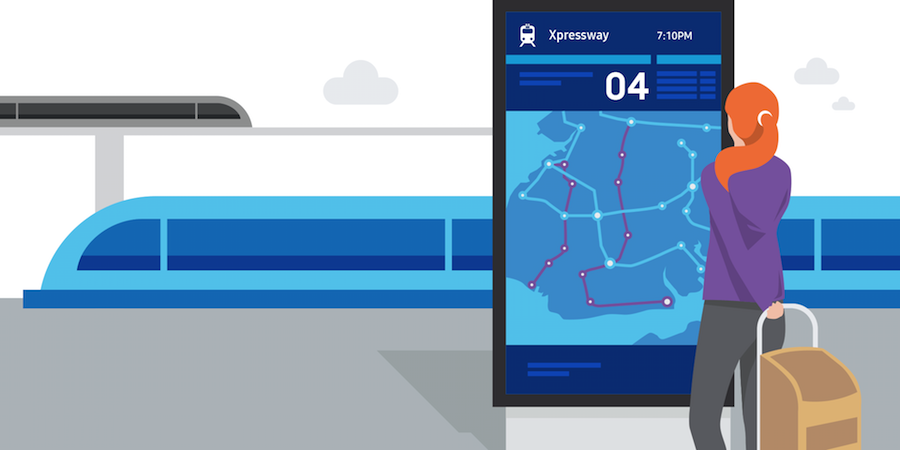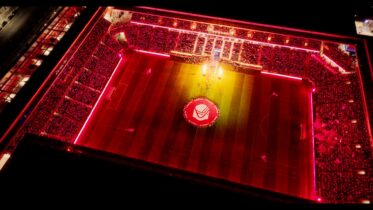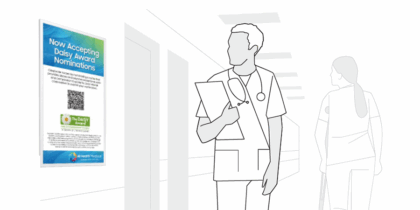Putting a bright digital display in a storefront or street-level office window can be an effective way to market to passersby and drive foot traffic through the front doors. But using that technology has tended to come with a compromise.
The screens look great from the street, but inside the building, staff and visitors are looking at a flat, dark slab of metal or plastic — the back end of a display or its enclosure.
The simple way around that has been to install pairs of screens back to back, but between the displays themselves, the mounting hardware and a lot of cables, the results were bulky and hard to manage.
That’s where Samsung’s dual-sided LCD screens are filling a need. Putting two LCD screens back-to-back in one super-slim enclosure cleans up the display. We’ve also tuned the brightness capabilities of each so the screen facing out to the street — and battling sunlight’s glare — is much brighter than the one facing inside.
Winning the ambient light battle
Screens in shop and office windows often disappoint their owners because they employ TVs or commercial monitors that are not engineered to the task. Where most TVs and indoor displays have 300 to 500 nits of light output, according to Lifewire, one side of the Samsung display pushes 3,000 nits. That’s enough potential brightness to counteract even direct midafternoon sunlight. Glare on screens with lower levels of brightness reduces or completely eliminates visibility.
Offices and shops have a lot of ambient lighting, and windows also let in a lot of natural light. So while the inside-facing screen does not need to be anywhere near as bright as the one facing out, it would be a mistake to assume a regular display with conventional brightness levels will do the job. To ensure visuals pop through any inside lighting conditions, the inside-facing screen of the dual display pushes 1,000 nits of brightness.
Both sides support full HD, and come in 46-in. and 55-in. versions.
Smartly packaged for clean presentation
The cleverness behind the design of a two-sided display also has to do with the way units are packaged. A street-level window is, for many businesses, among the first things consumers see when passing by. For that reason, what’s in there needs to look good and send the right message about a business.
Set back-to-back in a single enclosure, the two screens have a side profile of 55-mm., or a hair over 2-in. They are both powered by a single power cord, and have built-in networking, minimizing the clutter that can come with cabling.
Optimize Your Outdoor Signage
Learn how to leverage high-brightness displays to deliver clear, compelling communications in any weather. Download Now
The displays are “smart” — meaning they’re manufactured with powerful built-in media processors. That negates the requirement, bulk, complication and, most of all, the cost of a separate media player to drive each or both screens. The Smart Signage displays run Samsung’s Tizen operating system and come loaded with the Samsung MagicInfo digital signage management playback software. Dozens of third-party digital signage management software platforms are also configured to work with Samsung Smart Signage displays.
Mounting is also designer-friendly with slim, material- and color-matched pieces that allow screens to either be suspended from a ceiling, bulkhead or window frame, or mounted to the floor. The power cord, and any other necessary cables are hidden inside these pieces. The net result is an array screens that look like fixtures, not AV components.
Why window marketing?
So why put screens in windows? Because window marketing has been shown to attract attention outdoors and bring consumers inside. More generally, screen-based messaging does a better job than print in raising awareness.
With window displays, a wide variety of businesses use messaging to:
- Raise awareness that they’re open, as well as what services and offers are inside
- Convert awareness to familiarity
- Get people inside and turn them into customers
Screens also save the time and costs associated with producing printed materials, and the near-instant nature of digital makes the job of delivering timely and targeted promotions relatively simple.
Wide range of applications
Semi-outdoor signage has a place in a broad array of verticals.
- Retail: Street-facing screens are often used for call-to-action promotions intended to draw people inside, while the screens on the backside looking into the store tend to focus on information and branding. Those screens may be used for directories, driving awareness of new products, or online ordering and in-store pickup options.
- Quick Service Restaurants (QSRs): Outdoor screens drive promotions aimed at pedestrians and motorists, based on everything from the time of day to the different average diner profile that shifts through a day and week. The inside-facing screens offer everything from menus to special promotions, as well as operational matters such as raising awareness of mobile order options or part-time job opportunities aimed at high school and college students.
- Finance: Bankers use street-facing screens as part of broader local, regional or national marketing campaigns — offering continuity of messaging that consumers might also see in broadcast, out of home and online. They also try to attract new customers and prompt questions from existing ones about new services or attractive rates for savings, loans or credit cards. Inside, the focus becomes informing customers about the range of available services and options.
- Real estate: In large cities, real estate services are using screens in windows to drive awareness of listings for homes and condominiums — cycling through featured listings on the street-facing screen, while using the inside screens to reinforce the services, stature and overall value of that company’s services versus competitors.
- Public spaces: For mass transit, large stations can multitask windows — working with a media company on shared revenues from out of home advertising on outside-facing windows, while using the screens facing inside a terminal or station to provide service updates and other passenger-focused messaging.
The bottom line is just about any business that has a street-level presence — on a main thoroughfare or in a strip mall — has the opportunity to use window marketing to drive business and boost their communications strategy.
If a business is going to invest in window screens, it should fully understand not just any display will do the job well. Only a super-bright screen engineered for the task will be effective in full sunlight. And only a dual-sided display that’s tuned to the lighting and visibility challenges of windows, as well to the aesthetic demands of a window display, makes sense.
See how one Norwegian fashion chain brightened the sidewalk with Samsung digital signage. Get a jump-start on your own digital signage strategy with our free guide to navigating the basics.









